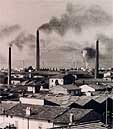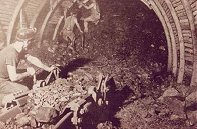
COKETOWN

|
|
|||||
 |
Charles Dickens
COKETOWN |
 |
|||
|
|
testo
|
||||
|
COKETOWN It was a town of red brick, or of brick that would have been red if the smoke and ashes had allowed it; but as matters stood it was a town of unnatural red and black like the painted face of a savage. It was a town of machinery and tall chimneys, out of which interminable serpents of smoke trailed themselves for ever and ever, and never got uncoiled. It had a black canal in it, and a river that ran purple with ill-smelling dye, and vast piles of buildings full of windows where there was a rattling and a trembling all day long, and where the piston of the steam-engine worked monotonously up and down like the head of an elephant in a state of melancholy madness. It contained several large streets all very like one another, and many small streets still more like one another, inhabited by people equally like one another, who all went in and out at the same hours, with the same sound upon the same pavements, to do the same work, and to whom every day was the same as yesterday and tomorrow, and every year the counterpart of the last and next. |
. |
Città del carbone Era una città di mattoni rossi o di mattoni che dovevano essere tali se il fumo e la cenere lo avessero permesso ma in realtà era una città di un rosso e di un nero innaturale come il viso dipinto di un selvaggio. Era una città di macchinari e di alte ciminiere; dalle quali interminabili serpenti di fumo si susseguivano senza interruzione, non finivano mai di srotolarsi. C’era un canale nero, un fiume purpureo che scorreva con una tintura maleodorante e enormi pile di costruzioni piene di finestre dove c’era un tintinnio e un tremore tutto il giorno e dove il pistone della macchina a vapore lavorava monotonamente su e giù come la testa di un elefante in uno stato di malinconica pazzia. La città conteneva molte strade larghe tutte uguali l’una all’altra e piccole strade sempre uguali l’una all’altra, abitate da persone tutte uguali e simili l’una all’altra che uscivano e rientravano alla stessa ora con lo stesso suono, sugli stessi marciapiedi per fare lo stesso lavoro e per le quali tutti i giorni erano come ieri e domani ed ogni anno la copia dello scorso e del prossimo. |
|
ANALYSIS
|
COMMENTO
|
|
Coketown is the classic city that reflects the period
of the Industrial Revolution: it’s an imaginery town but it’s possible
to locate Preston-city, near Manchester. |
Coketown è la classica città
che riflette il periodo della rivoluzione industriale:è una città
immaginaria ma è possibile individuare la città di Preston, vicino
Manchester. In questo brano possiamo individuare l’uso di molti simboli
che ci danno l’idea dei problemi esistenti all’interno di questa particolare
località. La città è descritta con colori diversi: " i mattoni di un rosso e nero innaturali","canali neri", "il fiume che scorre color purpureo"ed è dunque evidente l’atmosfera d’inquinamento causata dalle alte ciminiere e dai macchinari che lavorano continuamente "per sempre". La città appare monotona non solo nei colori ma anche nei rumori, nei suoni, negli edifici e nelle strade. E cosa dire degli abitanti? Come in un dipinto, le espressioni dei visi degli abitanti comunicano solo la malinconia e la tristezza della vita in questa città industrializzata. La gente ha perso la propria personalità, individualità: ogni individuo è simile all’altro e tutti assomigliano a dei robots. Tramite l’uso di metafore, possiamo chiaramente dedurre la presenza di due tipi di rischio i quali coesistano e causano non solo seri danni fisici (inquinamento) ma persino problemi psicologici. L’alienazione dovuta alla vita ripetitiva di Coketown è un messaggio significativo e preoccupante dell’esistenza del rischio psicologico che i lavoratori possono subire. |